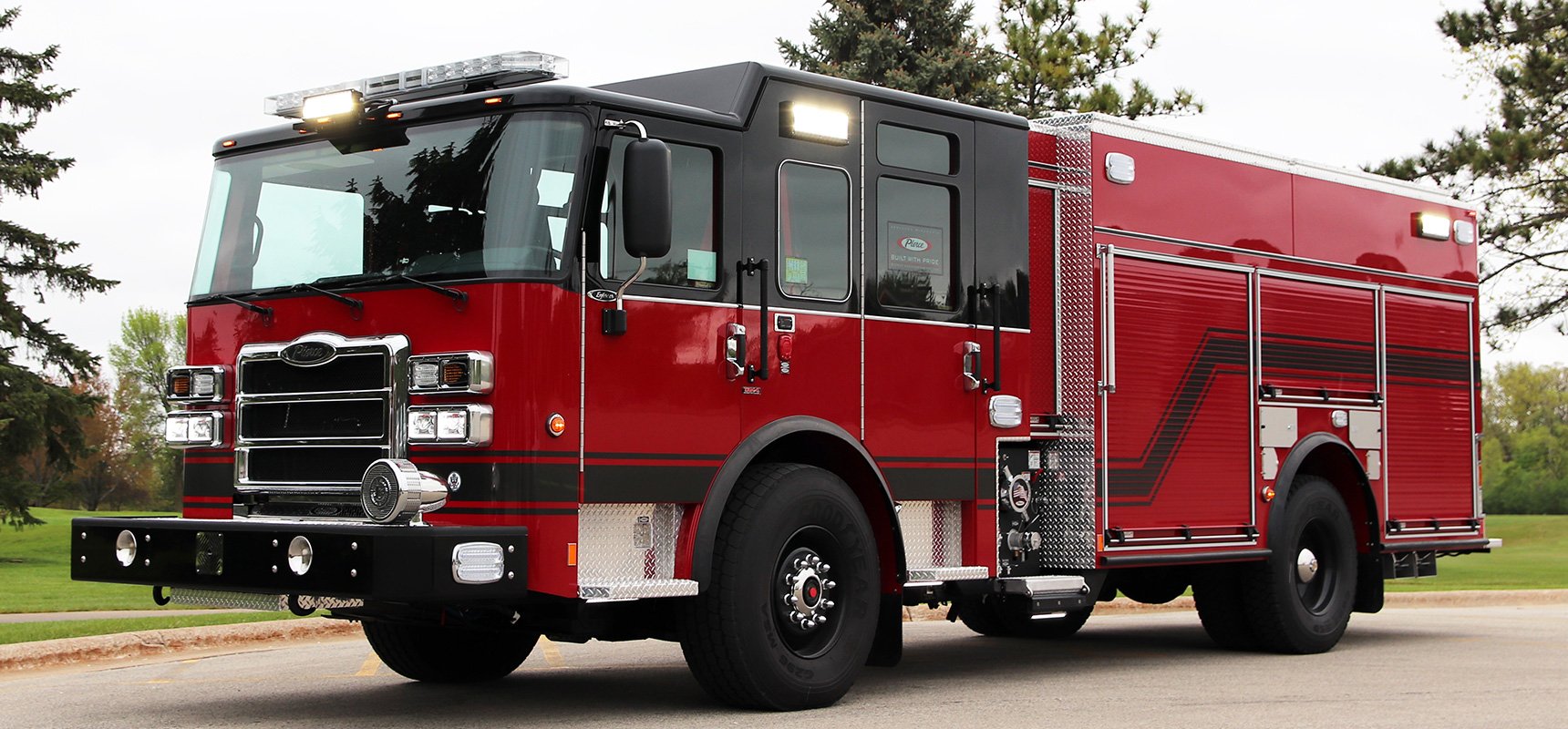
Crews respond to incidents at any time and in all conditions. It’s essential not to overlook the role fire truck scene lights play in the safety of both responders and the individuals involved in an incident. Whether departments are looking to replace existing technology or are in the process of designing a new fire apparatus, all scene lights for fire trucks should be specified to maximize crew performance throughout the life of an apparatus. The custom combinations and types of scene lights are numerous with the only real limitations being: available power, mounting space, and budget.
Where Can Fire Truck Scene Lighting Be Placed?
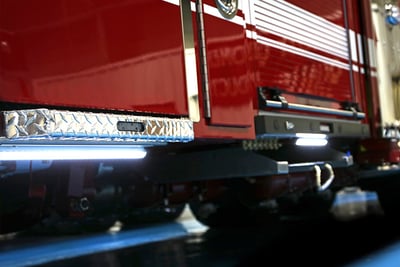 While emergency scene lighting can be mounted just about anywhere on an apparatus, to most effectively illuminate a scene the lights should be mounted as high as practical around the perimeter of the vehicle. Scene lighting can be surface or recess mounted, pedestal or pole mounted, visor or bail bracket-mounted or mounted in custom housings on the body of an apparatus. Some fire truck scene lighting can also be portable such as those lights mounted on tripod brackets.
While emergency scene lighting can be mounted just about anywhere on an apparatus, to most effectively illuminate a scene the lights should be mounted as high as practical around the perimeter of the vehicle. Scene lighting can be surface or recess mounted, pedestal or pole mounted, visor or bail bracket-mounted or mounted in custom housings on the body of an apparatus. Some fire truck scene lighting can also be portable such as those lights mounted on tripod brackets.
The most common areas scene lighting is placed on Pierce apparatus include:
- Top center of the cab
- High on the cab’s sides
- High on the body’s sides
- High on the rear of the body
- Either side of an aerial device
- Rear surface of the cab
- Above the pump house area
- On a basket
NFPA requirements dictate there must be scene lighting placed to illuminate the ground at least 10 feet directly behind an apparatus and anywhere crew members may step off the apparatus such as cab steps, a running board, or ladder. The water stream from an aerial water monitor must also be illuminated. In addition to areas off the vehicle, NFPA also requires all designated standing, stepping, and walking areas on the apparatus to be illuminated.
What Type Of Light Technology Is Used?
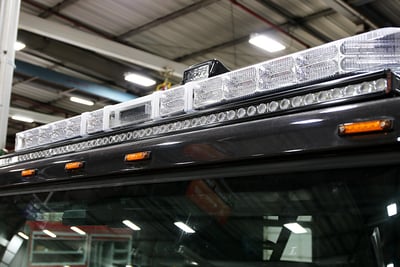 Scene light technology is expanding at an exponential rate and cannot be ignored when deciding which lights to include on your apparatus. Over the last ten years, the industry has made the successful conversion from primarily halogen to primarily light-emitting diode (LED) lighting systems because high wattage halogen bulbs proved to be inefficient, fragile, and offer a lower intensity light output. While LED scene lights for fire trucks require a higher initial investment, these lights offer a number of valuable features including:
Scene light technology is expanding at an exponential rate and cannot be ignored when deciding which lights to include on your apparatus. Over the last ten years, the industry has made the successful conversion from primarily halogen to primarily light-emitting diode (LED) lighting systems because high wattage halogen bulbs proved to be inefficient, fragile, and offer a lower intensity light output. While LED scene lights for fire trucks require a higher initial investment, these lights offer a number of valuable features including:
- More favorable light output to power consumption ratio
- Longer lifespan
- Instant “ON” ability
- Higher durability
- Ability to more closely recreate sunlight on the color spectrum
LED scene lighting systems are the most prominent technology now used in designing top performing scene lighting equipment.
Looking to expand your knowledge on emergency lighting technologies? We recommend our blog on Fire Apparatus Emergency Warning Lights, which provides valuable insights into the significance of warning lights in crisis scenarios.
What Is The Maximum Illumination Range For A Vehicle-Mounted Scene Light?
This depends on the power source and voltage rating of the light, as well as the type of bulb and lens, but some high-power LED scene lamps can light up buildings up to 300’ away from a stationed apparatus. Typically, banks of scene lights mounted on deployable towers on the top of the cab or body will provide the most effective overall scene lighting. With LEDs, it is also possible to combine a spot and flood pattern into one light to serve the near and far field of a scene.
What Are The Power Demands Of A New Fire Truck Scene Lighting Package?
LED scene lighting has a better light output to power consumption ratio than legacy technologies. However, it is important to understand how the output of your vehicle alternator or onboard generator should guide your scene lighting selections.
- Do you plan to operate off battery voltage (DC) or a generator (AC)?
- When do you plan to use your scene lights?
- Are you able to load manage your scene lights if the total amp draw of your vehicle exceeds the alternator's capacity?
How Customizable Is Fire Apparatus Scene Lighting?
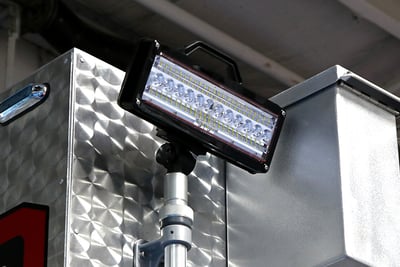 Many departments ask about the options available for customizing fire apparatus scene lighting packages. Pierce offers many options to customize the positioning and functionality of apparatus lighting including:
Many departments ask about the options available for customizing fire apparatus scene lighting packages. Pierce offers many options to customize the positioning and functionality of apparatus lighting including:
- Multiple switch locations
- Parking brake activation
- Door open activation
- Directional light activation
- Surface or recess mounted
- Pedestal or pole mounted
- Visor or bail mounted
Custom requests for scene light locations and activation methods can also be considered.
Who Are The Major Manufacturers Of Apparatus Scene Lighting?
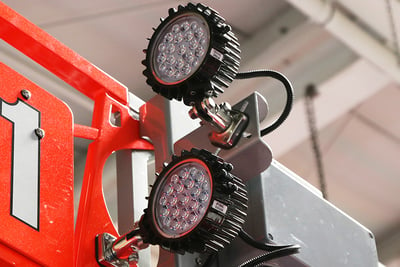 There are several reputable companies that develop the high-impact fire apparatus scene lighting systems used today.
There are several reputable companies that develop the high-impact fire apparatus scene lighting systems used today.
Whelen® offers several variations and options for scene lighting packages. The Whelen Pioneer™ series features lights that are easy to mount and are widely used.
Additionally, HiViz LED Lighting/Fire Tech continues to be favored for its low-profile brow light, the BG2 lighting system, which provides optimal light coverage in the front of an apparatus and can also be mounted in other locations.
Interested in learning more fire truck terminology? Check out Pierceopedia, an interactive fire truck glossary design to help you boost your knowledge of fire truck features, components and parts.
Looking Ahead
In the future, we’ll likely see fewer apparatus on the market that depend on expensive 120/240-volt generators to power scene lights for fire trucks and more apparatus with integrated 12-volt scene lighting packages. Considering voltage drop concerns over long 12-volt circuits and their effects on alternator capability, this evolution may pose challenges for older apparatus and some aerial devices. However, industry trends point toward updated scene lighting packages that decrease cost over the life of an apparatus and improve overall response outcomes.
Looking for examples of how Pierce Manufacturing can help you appropriately manage fire truck scene lighting? Take a look at our recent new deliveries.
Our team of experts at Pierce Manufacturing is always available to answer your questions and guide you through the process of selecting and customizing your fire apparatus. Contact your local dealer with any questions or concerns.
Do you have any questions about fire truck scene lights? Let us know in the comments below!